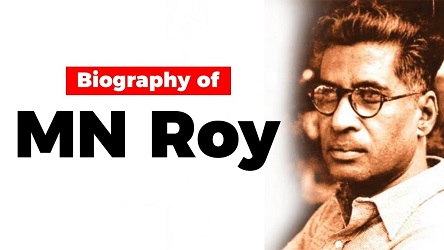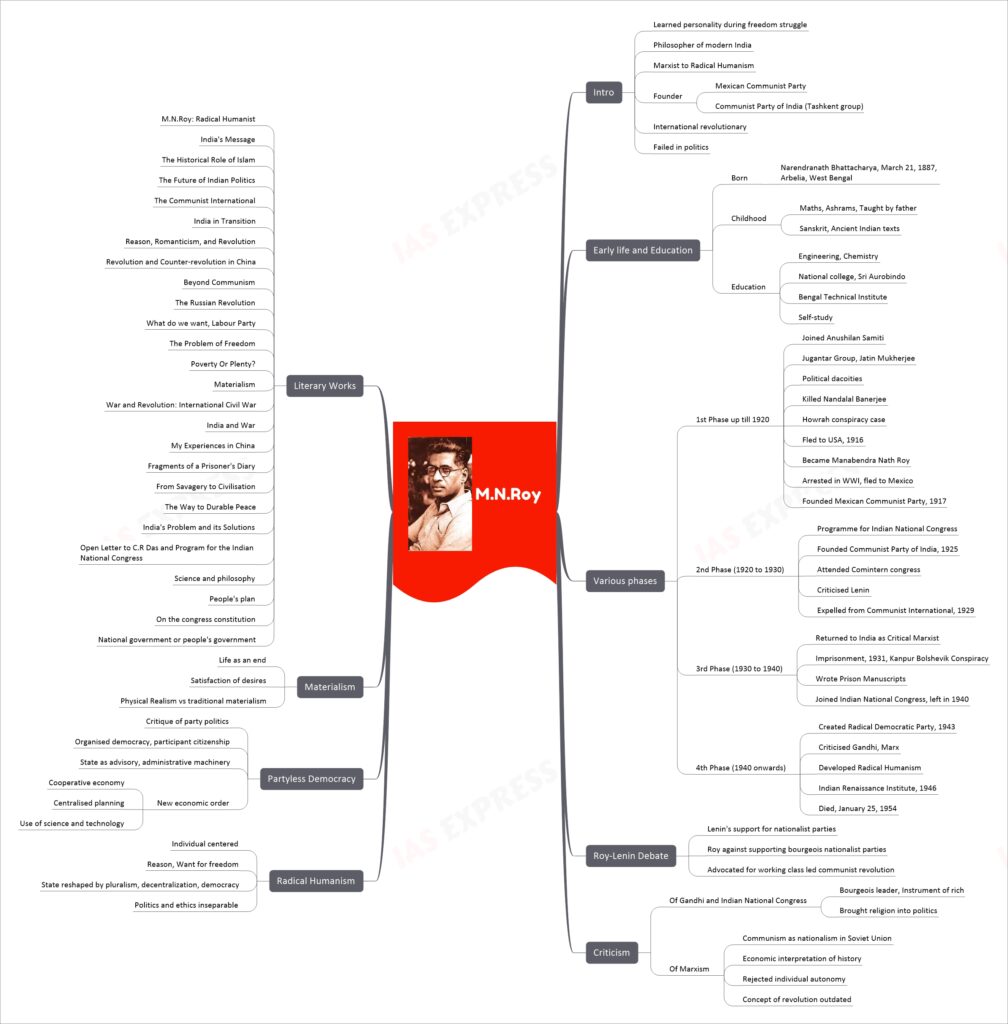M.N.Roy – Biography, Contributions, Ideologies, Books

Manabendra Nath Roy (M.N.Roy) was one of the most learned personalities during the freedom struggle and one of the few philosophers of modern India. He started as a Marxist but gradually moved towards Radical Humanism which is considered to be his biggest contribution. He is also one of India’s more colourful and unusual international revolutionaries. He was the founder of the Mexican Communist Party and the Communist Party of India (Tashkent group). He was a delegate to congress of the Communist International and Russia’s aid to China. He was one of the first leaders who injected Marxism into the practical politics of India. However, he was proved to be a complete failure in politics.
Early life and Education
Narendranath Bhattacharya, who later assumed the name Manabendra Nath Roy, was born on 21 March 1887, at Arbelia, West Bengal into a family of priests.
During his childhood, Roy visited maths and ashrams to educate himself. His father, Dinabandhu Bhattacharya, also taught him Sanskrit and ancient Indian texts.
He studied Engineering and Chemistry at the National college under Sri Aurobindo before moving to the Bengal Technical Institute. Much of his knowledge was gained through self-study.
Various phases of his life
1st Phase up till 1920:
- At 14, Roy joined the underground revolutionary organisation Anushilan Samiti. After it was banned, he helped to organise the Jugantar Group under the leadership of Jatin Mukherjee.
- Roy also participated in a series of political dacoities against British rule. In November 1908, he shot dead Nandalal Banerjee, the police officer who had arrested revolutionary Khudiram Bose (who was hanged to death).
- He spent 9 months in jail for the Howrah conspiracy case.
- Roy’s search for arms took him to the USA in 1916. Roy was tracked so closely by British Intelligence that the day he landed at San Francisco, a local newspaper published a report headlined, “Mysterious Alien Reaches America, Famous Brahmin Revolutionary or Dangerous German Spy.”
- This forced him to flee south to Palo Alto, California. It was here that he changed his name from Narendranath Bhattacharya and became Manabendra Nath Roy.
- He got influenced by radical socialist ideology.
- When the United States participated in WWI, Roy was arrested for his anti-colonial leanings. He jumped bail and escaped to Mexico.
- In Mexico, he became a vocal advocate of the socialist state and founded the Mexican Communist Party in 1917.
2nd Phase (1920 to 1930):
- In 1922, he prepared a detailed programme for the consideration of the Indian National Congress. In this, he proposed nationalization of railways, mines, waterways.
- Inspired by his experiences in Mexico, Roy founded the Communist Party of India in 1925 along with six other leaders at Tashkent now in Uzbekistan.
- He undertook a journey to Moscow to attend the second congress of Comintern (Communist International).
- He criticised Lenin’s thesis on the National and Colonial Question.
- By 1926, he was serving the policy-making bodies of Communist International.
- In 1927, he visited China to make the Chinese Communist Party implement guidelines by the Communist International and he was failed. Following this, he was expelled from the Communist International in September 1929.
3rd Phase (1930 to 1940):
- He came back to India in 1930 as a Critical Marxist.
- Roy was sentenced to six years imprisonment in 1931 for his involvement in the 1924 Kanpur Bolshevik Conspiracy case.
- While in jail, Roy wrote Prison Manuscripts, a set of nine thick volumes. These have not been published in totality.
- After his release in 1936, Roy joined the Indian National Congress. He tried to radicalize the congress from within towards the socialist goals.
- He left the party later in 1940 as a result of Congress’ reluctance to aid the British in World War II.
4th Phase (1940 onwards):
- He created Radical Democratic Party in 1943.
- He criticised Gandhi and Marx.
- He developed his own philosophy called New Humanism (initially) and Radical Humanism (later).
- In 1946, Roy established the Indian Renaissance Institute at Dehradun in order to develop the Indian Renaissance Movement.
- Roy died of a heart attack on 25 January 1954.
Roy-Lenin Debate on Colonial Struggle
Lenin:
- Comintern should support nationalist parties like INC in India and Kuomintang in China.
- Once imperialist powers are expelled, then efforts should be made for bringing communism.
M.N.Roy:
- Roy was against Lenin’s view.
- According to him, these nationalist parties are bourgeoisies parties and hence the communist should rather focus on building communist parties.
- He advocated the responsibilities to the working class to bring the communist revolution to India.
M.N.Roy’s criticism of Gandhi and the Indian National Congress
- Roy criticised Gandhi as the leader of bourgeoisie and an instrument of the rich class.
- He attacked Gandhi’s call for harmony between classes.
- According to Roy, Swaraj of Gandhi equals Swaraj for the capitalist class.
- He blamed Gandhi for bringing religion into politics.
M.N.Roy’s criticism of Marxism
- According to M.N.Roy, communism had degenerated into nationalism in the Soviet Union.
- He criticised the economic interpretation of history given by Marx.
- According to Roy
- Marx rejected the autonomy of the individual.
- Neither socialism nor communism but freedom should be the ideal of civilized society.
- The concept of revolution was outdated because the military power of the state had become great.
- Revolution should be by consent and guided by philosophy with universal appeal.
M.N.Roy’s Radical Humanism
- Radical humanism revolves around the individual or man.
- The individual should not be subordinated either to a nation or a class.
- Man has two basic traits:
- Reason: echoes the harmony of the universe.
- Want for freedom: as it leads him to a search for knowledge.
- Role of State:
- Roy was aware of the coercive character of the state.
- He wants to reshape the state on the basis of the principles of pluralism, decentralization, and democracy.
- The state must exist and discharge its limited functions along with other equally important autonomous social institutions.
- Moral Man:
- Politics should not be divorced from ethics.
- Roy traces morality to rationality in man.
- He advocates humanist politics.
M.N.Roy’s Partyless Democracy
- Roy criticises party politics because
- It denies the opportunity for individuals to participate in politics.
- It subsumes the power in itself.
- The right to vote does not ensure political participation.
- It leads to dishonesty and corruption.
- He formalised the notion of organised democracy and participant citizenship into a decentralised order, that is,
- Functions of the state shall be performed by free and voluntary associations of enlightened people.
- The state shall become advisory and administrative machinery.
- The new economic order under the new social setup should focus on:
- Cooperative economy: economic activity to be done at local, regional, state, and national levels through cooperatives.
- Centralised planning: Planning should be initiated at the grassroots level and so on.
- Science and technology: should be used to reconcile problems of economic development and human urge for freedom.
M.N.Roy’s Materialism
- As a materialist, Roy deliberated life to be an end in itself.
- The main purpose of life is to live and to live is to have the power and resources to satisfy the desires that naturally spring in man’s mind.
- Roy was a Benthamite who addressed Indians to believe in concepts like self-denial, simplicity, and the joy of satisfying one’s desires.
- In a broad sense, Roy’s philosophy was in the tradition of materialism.
- Differences between Roy’s materialism and traditional materialism:
- Roy’s materialism is a reinstatement of traditional materialism in the light of then-contemporary scientific knowledge.
- According to Roy, “The substratum of the Universe is not matter as traditionally conceived: but it is physical as against mental or spiritual. It is a measurable entity. Therefore, to obviate prejudiced criticism, the philosophy hitherto called materialism may be renamed Physical Realism”.
- Roy has discussed the nature of philosophy and its relationship with religion and science in his books.
M.N.Roy’s Literary Works
- M.N.Roy: Radical Humanist
- India’s Message
- The Historical Role of Islam
- The Future of Indian Politics
- The Communist International
- India in Transition
- Reason, Romanticism, and Revolution
- Revolution and Counter-revolution in China
- Beyond Communism
- The Russian Revolution
- What do we want, Labour Party
- The Problem of Freedom
- Poverty Or Plenty?
- Materialism
- War and Revolution: International Civil War
- India and War
- My Experiences in China
- Fragments of a Prisoner’s Diary
- From Savagery to Civilisation
- The Way to Durable Peace
- India’s Problem and its Solutions
- Open Letter to C.R Das and Program for the Indian National Congress
- Science and philosophy
- People’s plan
- On the congress constitution
- National government or people’s government


Important works of mn roy